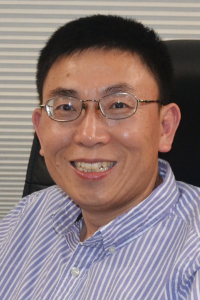Skin misfolded proteins and neurodegenerative diseases

Dr. Wen-Quan Zou
April 12 at 12:20pm in the Fralin Auditorium, Fralin Hall room 102
Hosted by Dr. B. Xu
Dr. Wenquan Zou is Associate Professor from the Departments of Pathology and Neurology, and Associate Director of National Prion Disease Pathology Surveillance Center, Case Western Reserve University School of Medicine, Cleveland, Ohio.
Dr. Zou received his medical degree from Jiangxi Medical College and his Ph.D. from Shanghai Medical University, China. He has practiced Internal Medicine and Nephrology in China for six years. His post-doctoral work in neurodegenerative diseases, with a concentration in prion diseases, was done at the Institute of Pathology, Case Western Reserve University, Cleveland, Ohio and at the Centre for Research in Neurodegenerative Diseases, University of Toronto, Toronto, Canada.
Dr. Zou’s research focus is in the area of prion disease and other neurodegenerative diseases such as Alzheimer’s disease and Parkinson’s disease. Currently, the Zou laboratory is developing both patient-specific authentic cell models for studying human prion diseases and skin-based early diagnostic tests for prion disease and other neurodegenerative diseases. His research has been well-funded by NIH and CDC grants. He is an ad hoc grant reviewer for NIH and Alzheimer’s association and an ad hoc paper reviewer for more than 50 journals including New England Journal of Medicine, Acta Neuropathologica, Annals of Neurology, PLoS Pathogens, Cell Reports, etc.
Neurodegenerative diseases (NDDs) from the most common Alzheimer’s disease (AD) and Parkinson’s disease (PD) to the rare Creutzfeldt-Jakob disease (CJD) are all associated with the accumulation and deposition in the brain of misfolded protein aggregates such as tau and amyloid-ß in AD, disease-associated a-synuclein (αSynD) in PD, and prions in CJD. Several lines of evidence have recently indicated that all these misfolded proteins may share a prion-like seeding activity to propagate and spread during the disease procession. Currently, a definitive diagnosis of these disorders virtually all depends on the examination of highly intrusive biopsy or autopsy brain samples for detection of the misfolded proteins. Using advanced technologies to identify biomarkers in more accessible specimens will be conceivably important for their diagnosis, defining disease diversity, and assessing therapeutic efficacy. Notably, several misfolded proteins, the molecular hallmarks in NNDs, have been detected in the skin of patients with CJD by ultrasensitive technology such as real-time quaking-induced conversion (RT-QuIC) assay, or patients with AD or PD by immunohistochemistry or immunofluorescence microscopy. In this presentation, Zou will share his recent research work on the development of diagnostic tests using skin misfolded proteins as biomarkers for diagnosis of prion disease, PD and AD.
- Orrú CD, Yuan J, Appleby BS, Li B, Li Y, Winner D, Wang Z, Zhan YA, Rodgers M, Rarick J, Wyza RE, Joshi T, Wang GX, Cohen ML, Zhang S, Groveman BR, Petersen RB, Ironside JW, Quiñones-Mateu ME, Safar JG, Kong Q, Caughey B, Zou WQ. Prion seeding activity and infectivity in skin samples from patients with sporadic Creutzfeldt-Jakob disease. Sci Transl Med. 2017 Nov 22;9(417). pii: eaam7785. doi: 10.1126/scitranslmed.aam7785.
- Dang J, Zou WQ. Neurodegenerative Protein Misfolding Disorders and the Skin (2017) Neurodegenerative Protein Misfolding Disorders and the Skin. Ann Neurodegener Dis 2(1): 1025.
- Htike TT, Mishra S, Kumar S, Padmanabhan P, Gulyás B. Peripheral Biomarkers for Early Detection of Alzheimer's and Parkinson's Diseases. Mol Neurobiol. 2018 Jul 14. doi: 10.1007/s12035-018-1151-4.
- Donadio V, Incensi A, Rizzo G, Scaglione C, Capellari S, Fileccia E, Avoni P, Liguori R. Spine Topographical Distribution of Skin α-Synuclein Deposits in Idiopathic Parkinson Disease. J Neuropathol Exp Neurol. 2017 May 1;76(5):384-389.

This seminar will NOT be livestreamed or recorded.


